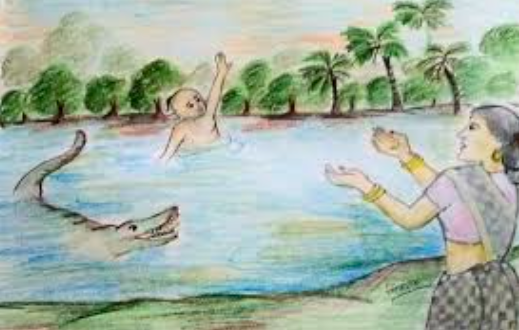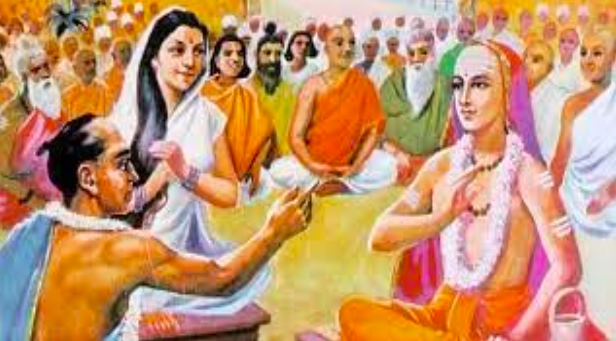Jagat Mithya, Brahman Satyam.
The world is an illusion, only Brahman or Pure Consciousness or God is the reality.
An ideal sanyasi, Adi Shankaracharya, walked this Earth 1200 years ago. A great Hindu philosopher and theologian, he single-handedly structured and reordered a fractured Hindu society and made it into the dynamic and all-encompassing religion it is today. He was also the founder of the Advaita Vedanta school of philosophy.

The birth of Shiva Avatar:
Adi Shankaracharya or Shankara as he was known was born in a poor Brahmin Namboodiri family. When his parents Sivaguru and Aryamba prayed to Lord Shiva to grant them a child, the Lord came to Aryamba in a dream and promised her that he would take birth as her baby boy.
Thus Shankara is also considered by many to be a reincarnation of Shiva.
Lord Shiva also gave the father a choice, he could either have a son with a long sedate lifespan or a short one with eternal fame. Sivaguru chose the latter one and this choice gifted India one of its greatest sons.
When he was seven years old, he lost his father and was brought up by his mother and taught scriptures by her.

A mother’s assent:
From a young age, he astounded everyone with his keen intellect and his strong leaning towards spirituality. As a young child, he once watched a play on Nachiketa and his conversations with Yama the god of death by a traveling drama company. He was so influenced by this that he wanted to renounce the world and become a monk, but his mother opposed this idea.
One day he went to bathe in a nearby river. Soon a friend of his ran up to his mother and informed her that Shankara was in the grip of a crocodile. The mother ran to the river and implored him to flee the crocodile’s jaws. But Shankara was adamant that he would only try to save himself if she gave him permission to become a hermit. The mother agreed and lo and behold! The crocodile released him and quietly swam away. But his mother made him promise to return to perform her last rites. Shankara agreed.
A great child prodigy:
At the age of 8, Shankara left his home in search of his guru and ultimate enlightenment. From his home in southern Kerala, young Shankara walked 2000kms to reach the banks of the river Narmada, to reach his guru, Govindapada. For four years he served and studied under the benevolent guidance of his guru and mastered all the Vedic scriptures.
When Shankara was 12 years old, his guru considered him well versed in all the religious texts and commanded him to write commentaries on the hidden meanings contained in the scriptures. By the age of 16, within 4 years, Shankara had completed all the written treatises, explaining the esoteric, hidden meanings in the great scriptures and put down his pen.
Miracle of river Narmada:
At one time during the rainy season, the river Narmada was in spate. It overflowed its banks and caused havoc in the region. It was feared that it would submerge the cave where Govindpada was meditating. When Shankara learned about the situation he placed his Kamandalu or water pot at the entrance of the cave and invited all the waters of the river to flow into it. The river obeyed his command and flowed into the Kamandalu and his guru’s meditation went on undisturbed.
Now his guru deemed the young lad to be fit to propagate his teachings in the world. So for the next 16 years of his life, Shankara roamed the length and breadth of ancient India 3 times enlightening the masses with the life force of the Vedas:
“Brahman or Pure Consciousness is the Absolute Reality. The World is Unreal, this is the True Understanding of the Shastras and is the THundering Declaration of the Vedantas”.
During that time India had degraded into superstition and rituals and misinterpretation of the scriptures. Shankara’s religious strategy was to engage influential leaders of various religious sects in debates. None could win over him and the leaders eventually accepted his truth and wisdom and considered him as their Guru. This led to a mass acceptance of his teachings by their vast number of followers too.

The four Maths or Ashrams (Char Dham):
Shankara then traveled across India in his quest to unify the people. At that time the sannyasis across India differed in their beliefs and their religious rituals. To bring consensus and uniformity in the great Hindu religion, Shankaracharya walked the length and breadth of India 3 times to spread his gospel of unification of the Hindu society.
Adi Shankaracharya established 4 maths in the four corners of India and recruited four of his most able disciples to spread the principles of Advaita through ardent teaching of the masses.
Each of these maths was given one Veda for posterity, to guard and to teach, and also a Maha Vakya. He also established pilgrim routes between these 4 Maths and the Jyotirlingas and the Shakti Peeth temples across India.
Establishing akharas:
He then organized the various akharas of hermits where they were taught to use their knowledge and yogic and physical powers to protect Hinduism. The hermits were taught to protect the pilgrim routes and also offer protection during the Kumbh Mela.
The six sect system of worship:
Shankaracharya established the six sect system of service to counter the practices of innumerable sects following their own narrow philosophies and rigid rituals of worship. This system highlighted the main gods: Vishnu, Siva, Shakti, Muruka, Ganesha, and Surya. He also promulgated the religious rituals and rites to be conducted in all temples across India. Shankara taught the people that even though deities manifested in different forms they were ultimately the one Brahman, the invisible Supreme Being.
He brought the pure essence of Sanatan Dharma, which is Love, Compassion, and Universal regard for every human being, back into existence. It had been lost in the rigmarole of blind superstitious beliefs.
Adi Shankaracharya’s Works:
1. He wrote 18 commentaries on major religious scriptures like the Bhagavad Gita, Brahmasutras, and 12 major Upanishads.
2. He wrote 23 books on the principles contained in the Advaita Vedanta philosophy, including Viveka Chudamani, AtmaBodha, Vakya Vritti, Upadesa Sahasri, etc.
3. 72 devotional hymns and meditational hymns like Soundarya Lahari, Nirvana Shatakam, Maneesha Panchakam.
Influence on Hinduism:
Adi Shankaracharya had a great impact on Hinduism, he was one of the greatest thinkers to have walked this Earth. In his short lifespan of 32 years, he traveled the length and breadth of the Indian subcontinent several times. A nearly impossible feat to achieve without modern transportation.
He united a fractured Hindu society and formulated the principles of Advaita Vedanta. He brought together under the umbrella of Sanatan Dharma all the warring factions of Hindu society and established a firmament of religious practices and rituals to be followed.
His treatises on all the great scriptures are considered as gospel even today.
He established four Maths or Char Dhams or monasteries in the four corners of India and set parameters of rituals and religious practices and the religious syllabus to be taught in each of the Maths.
Adi Shankaracharya’s accomplishments despite his short lifespan of 32 years are truly Godlike and he is considered to be an avatar of Lord Shiva.
Interested in becoming a yoga teacher?
Newsletter
Upcoming events and latest blogs